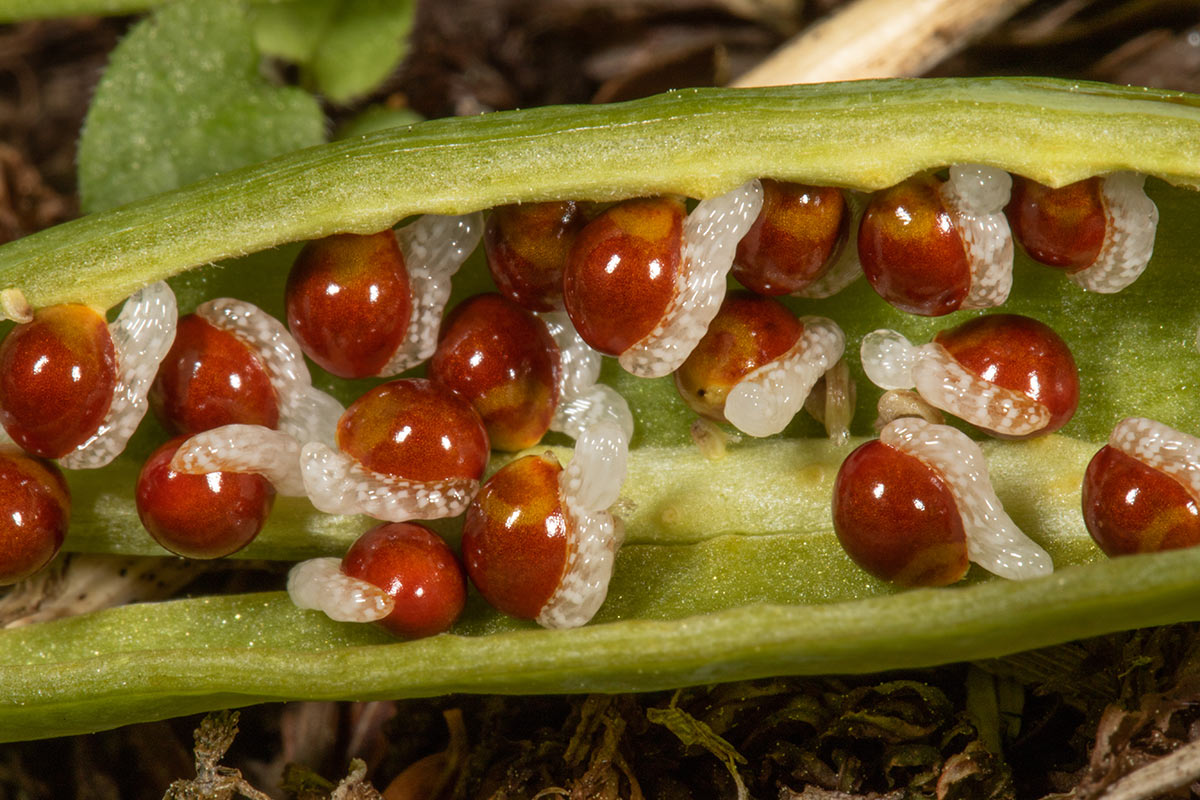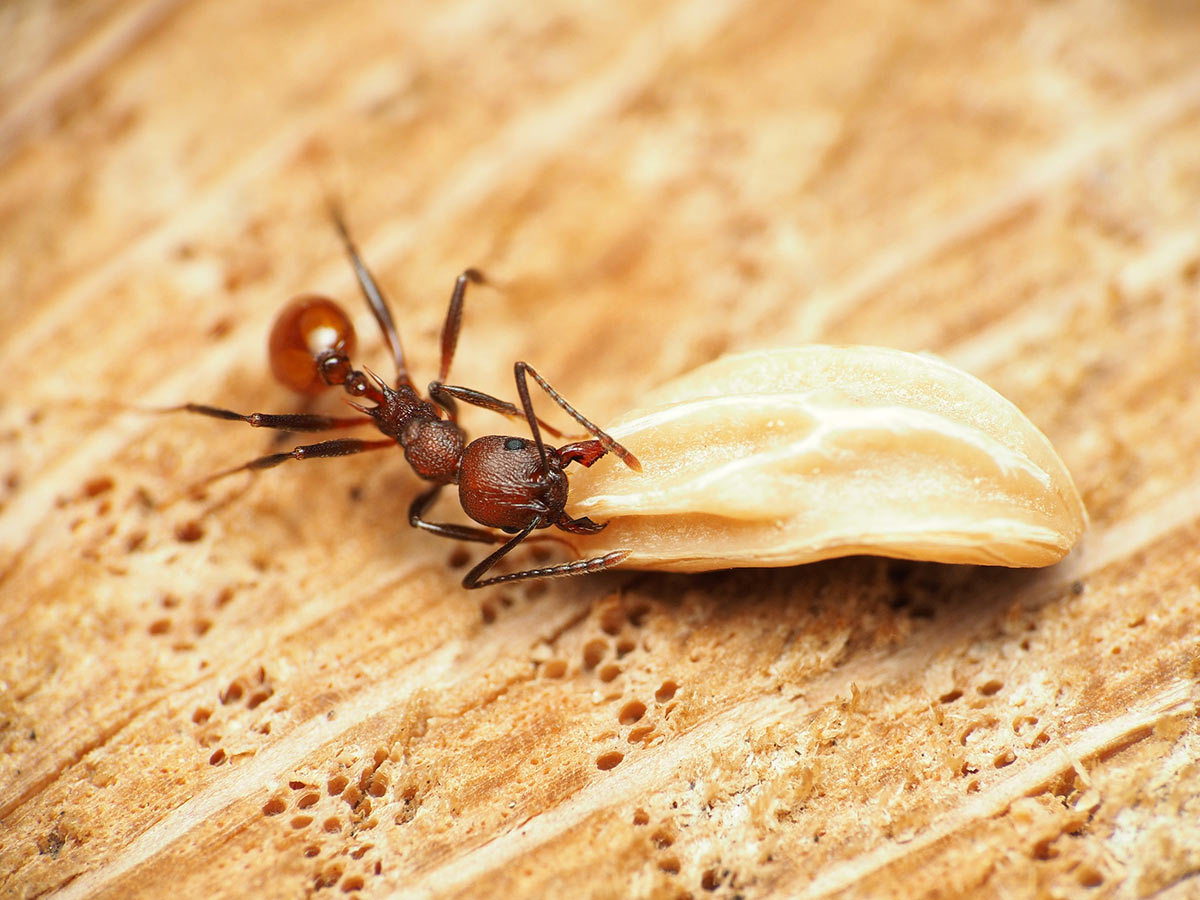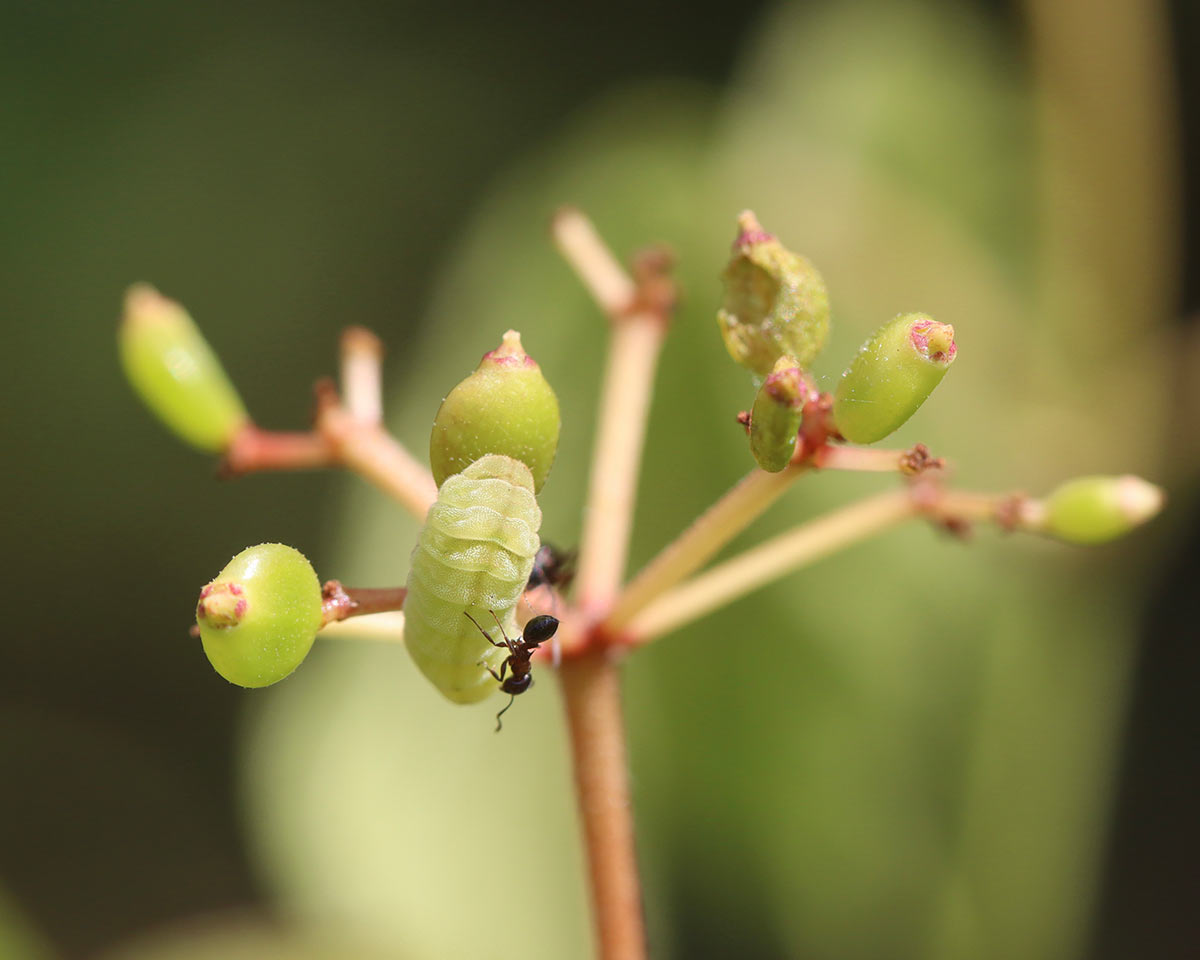By Julie Michaelson
While touring a friend’s garden this spring, we noted some of the bloodroot (Sanguinaria canadensis) she planted had strayed far from its intended location. What used to be a small bloodroot patch now formed an almost continuous trail that wrapped around her house, even popping up in the cracks between the pavement! This was a welcomed surprise but perplexing. How did it wander so far?
Some plants like jewelweed (Impatiens spp.) and lupine (Lupinus spp.) have seed pods that act as a catapult and launch seeds over half a meter. Other plants like maples (Acer spp.) and dandelions (Taraxacum spp.) have structures that enable the seed to take flight–in the case of dandelions, sometimes traveling up to 100 km! Burdock (Arctium spp.) and tick trefoil (Desmodium spp.) have sticky seeds that cling to the fur or clothing of a passerby.
Bloodroot has none of these features. What they do have is a food offering that attracts organisms with legs to do the heavy lifting!
 Bloodroot is a fragile spring flower that grows well in moist, rich soils in shady conditions. The flower produces no nectar, but the pollen is readily utilized by early spring pollinators like some of our native mining bees (Andrena spp.). (Photo Credit: Cbaile19 CC0)
Bloodroot is a fragile spring flower that grows well in moist, rich soils in shady conditions. The flower produces no nectar, but the pollen is readily utilized by early spring pollinators like some of our native mining bees (Andrena spp.). (Photo Credit: Cbaile19 CC0)
For some plants, ants are the secret ticket to transportation
When we think of animals that help move seeds to new places, we often credit birds (which undoubtedly play a vital role), but they aren’t the only ones! Many plants have actually evolved to depend on one group of insects to disperse their seeds: ants!
This seed-carrying partnership between plants and ants is called myrmecochory. Both sides often benefit from working together. Plants that use ants to disperse their seeds evolved to have seeds with a fat-filled structure on their exterior called an elaiosome. The elaiosome is a delicious snack to an ant but just an expendable accessory for the seed!

The gelatin-like elaiosomes on these bloodroot seeds may look like a slime or fungus feeding on the seed, but they are in fact made by the seed itself. (Photo Credit: Kent McFarland CC-BY-NC)
Ants carry the entire seed into their nest beneath the soil surface and feed on the elaiosome. They deposit the leftover seed into their “trash piles”, which end up being a perfect nursery for the seed to develop! Ants’ trash piles are underground heaps of decaying plant and animal material, which are full of nutrients. Thanks to the ants, the seeds get carried away from their parent plant, buried in nourishing soil, and are protected from predators, like slugs and mice, that would eat the entire seed, not just the elaiosome.
Partnerships with ants are vital to many different organisms
Myremecochory is a widespread phenomenon, with over 11,000 plant species worldwide depending on this partnership! In the deciduous forests of eastern North America, approximately ⅓ of non-woody understory species rely on ants to disperse their seeds! It’s estimated that 55-60% of understory stems got to where they are growing thanks to ant activity. Myrmecochory is particularly important for spring ephemerals like bloodroot (Sanguinaria canadensis), trillium (Trillium spp.), Dutchman’s breeches (Dicentra cucullaria), trout lily (Erythronium americanum), and spring beauty (Claytonia virginica).
In eastern North America, ants in the genus Aphaenogaster are the species doing the majority of the work. Aphaenogaster ants nest in leaf litter and woody debris on the ground. Because of this, they may be particularly impacted by practices, like plowing, that disturb the soil and their nesting sites. Climate change and the loss of the forest canopy overhead are also potential threats. Some Aphaenogaster species can tolerate cooler conditions, but struggle more in high temperatures. When Aphaenogaster populations are abundant and stable, so is seed dispersal. However, if conditions change that are not favorable to one or more Aphaenogaster species, the plant communities that rely on them may struggle to persist or recover after disturbances.

Aphaenogaster worker ants can often be spotted carrying seeds back to their nest (Photo: Katja Shculz CC-BY)
There are some animals that have a similar partnership with ants, exchanging protection or transportation for food. Gossamer-winged butterflies like the endangered Karner blue (Lycaeides melissa samuelis) are tended by ants as caterpillars. Stick insects lay eggs that have an edible structure, just like a seed’s elaiosomes, that feed ants in exchange for carrying the egg to their nest, where it will hatch safely. Similarly, a recent discovery by a curious 8-year-old exploring their backyard found that certain wasps make galls in oak leaves, within which it lays its eggs, that also have an elaiosome-like structure that attracts ants!

Food is usually the secret to getting help from ants. Some caterpillars provide a sugary secretion to ants, who protect them from predators in return. (Photo Credit: Julie Michaelson)
Ants are a vital part of the ecosystem and worth protecting
Ants are so closely entwined with the life cycle of so many different organisms that by conserving ants, we can also protect many key parts of the ecosystem. Ants are often “keystone species”; their diversity, biomass, and behavior profoundly affect the habitats they reside in and the plant and animal communities they live alongside. The elaborate tunnels and galleries they excavate help loosen the soil, allowing moisture, nutrients, and air to get deeper into the ground. Ants carry leaf litter, prey, and other food items deep into the soil, which then are broken down by other invertebrates and microbes into the nutrients plants need to grow.
After looking at the bloodroot trail in my friend’s garden, I shared the wonderful relationship between ants and bloodroot seeds. Her eyes lit up. She recalled picking up one of the large flat stones on a walking path one evening only to discover an ant colony that, at first glance, looked like they had plentiful eggs but, upon further inspection, turned out to be seeds! A little ecological knowledge can go a long way to helping us understand the world around us.
Once a plant produces seeds, pollinators can dust off their legs to celebrate a job well done, but for ants, there is still much to do. So, a month after pollinator week, I think it’s a good time to celebrate and thank ants for sustaining diverse natural plant communities!
Learn more about ants carrying seeds
Authors
As the Connecticut River Valley pollinator conservation planner, Julie collaborates with the USDA Natural Resource Conservation Service (NRCS) and the American Farmland Trust (AFT) to provide technical support, training, and conservation planning assistance to producers and land managers seeking to develop pollinator and beneficial insect habitat.






